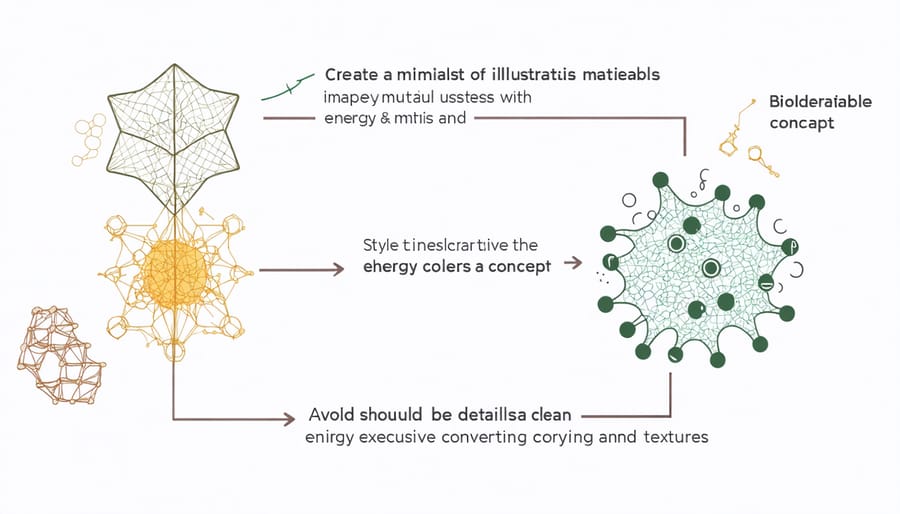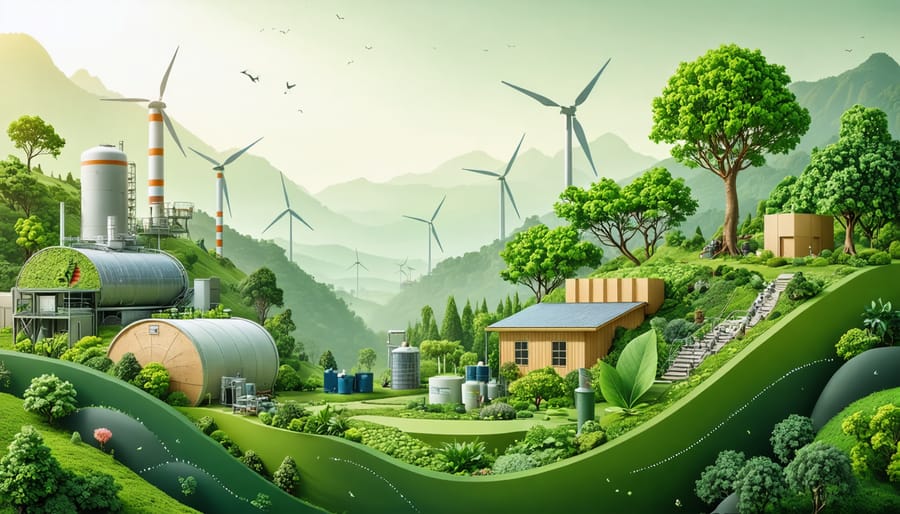In the race against environmental degradation, biodegradable materials have emerged as a revolutionary solution transforming how we approach sustainability and waste management. These innovative materials, designed to decompose naturally without leaving harmful residues, are reshaping industries and supporting circular bioeconomy principles across Australia and beyond.
From packaging that dissolves in water to construction materials that return to the earth, biodegradable alternatives are proving that environmental responsibility and industrial progress can coexist harmoniously. This shift represents more than just a trend – it’s a fundamental reimagining of how materials can serve human needs while protecting our planet’s future.
Australian innovators are leading this transformation, developing breakthrough materials that combine durability during use with complete biodegradability at end-of-life. These solutions are already making waves across sectors from agriculture to consumer goods, demonstrating that sustainable alternatives can match or exceed the performance of traditional materials while dramatically reducing environmental impact.
The potential of biodegradable materials extends far beyond waste reduction, offering pathways to regenerative manufacturing processes that could help restore natural ecosystems rather than depleting them. As we stand at this crucial environmental crossroads, these materials represent one of our most promising tools for building a truly sustainable future.
The Science Behind Biodegradable Materials in Energy Production
Key Properties of Biodegradable Materials
Biodegradable materials possess several key properties that make them invaluable for sustainable energy solutions. These materials naturally break down into simpler compounds through the action of microorganisms, typically within a few months to a year under proper conditions.
One essential characteristic is their organic composition, which allows natural decomposition without leaving harmful residues. Most biodegradable materials contain carbon-based compounds that microbes can easily digest and convert into natural byproducts like water, carbon dioxide, and biomass.
The moisture content plays a crucial role in the breakdown process. Materials with optimal moisture levels of 40-60% provide the ideal environment for microbial activity. Temperature sensitivity is another vital property, with most biodegradable materials decomposing efficiently between 20-40°C, conditions commonly found in Australian composting facilities.
Chemical structure accessibility is equally important. Materials with exposed chemical bonds and simple molecular structures tend to break down more quickly than those with complex, tightly bound molecules. This is why many Australian manufacturers are now focusing on developing materials with optimised molecular arrangements.
Surface area also influences biodegradability rates. Materials with greater surface area exposure to environmental factors and microorganisms decompose more efficiently. This principle is particularly relevant in large-scale composting operations across Australia, where material size reduction is often the first step in processing.
These properties work together to ensure materials can return to nature’s cycle, supporting our transition to a more sustainable future.
Breakdown Processes and Energy Generation
Biodegradable materials break down through a fascinating natural process that not only returns nutrients to the soil but also creates valuable energy. When these materials decompose, microorganisms like bacteria and fungi work to break down complex organic compounds into simpler elements. This process occurs in two main stages: aerobic decomposition, which happens with oxygen, and anaerobic decomposition, which takes place without it.
During aerobic breakdown, microorganisms consume the organic matter, producing carbon dioxide, water, and heat. This process is what we see happening in our garden compost bins, where food scraps and green waste transform into rich soil. In anaerobic conditions, such as in modern biodigesters, different bacteria break down the materials to produce methane-rich biogas, which can be captured and used for energy generation.
In Australia, several waste management facilities are harnessing this natural process through industrial-scale composting and anaerobic digestion. For example, the Earthpower facility in Sydney processes over 50,000 tonnes of food waste annually, converting it into renewable energy and nutrient-rich fertiliser. The biogas produced through this process can power homes, fuel vehicles, or generate electricity for the grid.
The speed of biodegradation depends on various factors including temperature, moisture, and the material’s composition. While some materials might break down in weeks, others take several months, but all eventually return to nature’s cycle, making them a truly sustainable choice for our future.

Australian Success Stories: Biodegradable Materials in Action
Agricultural Waste to Energy
Australian farmers are leading the way in transforming agricultural waste into valuable energy resources, demonstrating the incredible potential of biodegradable materials in sustainable power generation. The Darling Downs region in Queensland offers a compelling example, where the Dalby Bio-Refinery converts sorghum waste into bioethanol and power, supplying enough electricity for 2,000 local homes while reducing agricultural waste.
In Victoria’s Goulburn Valley, fruit growers have implemented an innovative waste-to-energy system that processes discarded fruit and organic matter into biogas. This system not only manages waste effectively but also powers their cold storage facilities, cutting energy costs by 70% and significantly reducing their carbon footprint.
The Southern Meats processing facility in Goulburn, NSW, showcases another successful initiative where livestock waste is converted into biogas through anaerobic digestion. This system generates enough power to meet 50% of the facility’s energy needs and has slashed their waste management costs.
These success stories aren’t limited to large operations. Small-scale dairy farmers across Tasmania are using portable biodigesters to convert animal waste and crop residues into biogas for heating and electricity generation. This approach has proven particularly valuable in remote areas where grid connectivity is challenging.
The benefits extend beyond energy production. Farmers report improved soil health from the digestate by-product, reduced odour issues, and decreased dependency on chemical fertilizers. This circular approach to waste management demonstrates how agricultural businesses can transform what was once considered a disposal problem into a valuable energy resource while supporting Australia’s renewable energy targets.

Industrial Applications
Australian industries are increasingly embracing biodegradable materials in their operations, leading to innovative solutions across various sectors. The packaging industry has been at the forefront, with companies like BioPak pioneering compostable food service products that break down completely within 120 days in commercial composting facilities. These products are now widely used in cafes and restaurants nationwide, significantly reducing plastic waste.
In agriculture, biodegradable mulch films are revolutionizing farming practices. These films, made from plant-based materials, naturally decompose into the soil after harvest, eliminating the need for removal and disposal while improving soil health. Major agricultural regions in Queensland and Victoria have reported successful implementations, with some farmers reducing plastic waste by up to 90%.
The construction industry has also jumped on board, incorporating biodegradable materials into modern waste-to-energy systems. Companies like EcoBuilder Australia are using mycelium-based insulation and biodegradable formwork that naturally decompose after serving their purpose, contributing to more sustainable building practices.
Manufacturing sectors have found success with biodegradable packaging materials derived from agricultural waste. Adelaide-based manufacturers have developed innovative solutions using grape waste from local wineries, creating sustainable packaging that breaks down completely within six months. This circular approach not only addresses waste management but also creates new revenue streams for agricultural businesses.
The textile industry is another significant adopter, with Australian fashion brands increasingly using biodegradable fabrics made from materials like eucalyptus pulp and seaweed fibers. These materials offer comparable performance to traditional textiles while ensuring end-of-life biodegradability.
Environmental and Economic Benefits
Carbon Footprint Reduction
Biodegradable materials play a crucial role in carbon footprint reduction through bioenergy and sustainable waste management practices. Unlike conventional materials that persist in landfills for centuries, biodegradable alternatives break down naturally, releasing significantly fewer greenhouse gases during their lifecycle.
When biodegradable materials decompose, they complete a natural carbon cycle rather than introducing additional carbon into the atmosphere. This process is particularly important in Australia, where landfill emissions account for a substantial portion of our national carbon footprint. By switching to biodegradable alternatives, businesses and communities can reduce their methane emissions by up to 80% compared to traditional waste disposal methods.
The manufacturing process of biodegradable materials also typically requires less energy and produces fewer emissions than conventional materials. For instance, biodegradable packaging made from agricultural waste products in Victoria has shown a 60% reduction in carbon emissions during production compared to traditional plastic packaging.
These materials often come from renewable sources such as corn starch, sugarcane residue, and other plant-based materials that actually absorb carbon dioxide during their growth phase. This creates a more balanced carbon equation, where the emissions from decomposition are offset by the carbon sequestration during plant growth. Many Australian farmers are now participating in this sustainable cycle by growing crops specifically for biodegradable material production, contributing to both environmental protection and rural economic development.

Economic Advantages
The shift towards biodegradable materials presents compelling economic opportunities for businesses and communities alike. As consumer demand for sustainable products continues to rise, companies embracing biodegradable alternatives are seeing significant market growth. In Australia, the biodegradable materials sector is projected to grow by 15% annually over the next five years, creating new jobs and business opportunities across the supply chain.
Cost savings emerge through reduced waste management expenses, lower carbon tax implications, and decreased reliance on traditional packaging materials. For instance, several Australian food delivery services have reported up to 30% reduction in packaging costs after switching to biodegradable alternatives, while simultaneously improving their brand image and customer loyalty.
The agricultural sector particularly benefits from biodegradable materials, with farmers saving on disposal costs and gaining additional revenue through the sale of agricultural waste for biodegradable material production. Success stories include Tasmania’s mushroom farming industry, where biodegradable packaging made from agricultural waste has created a profitable circular economy model.
Government incentives and grants for sustainable business practices make the transition to biodegradable materials more financially attractive. Many Australian businesses are eligible for tax benefits and innovation funding when investing in biodegradable solutions, creating a win-win situation for both the environment and their bottom line.
The export potential for Australian-made biodegradable materials is also promising, with growing demand from Asian markets seeking sustainable alternatives to traditional materials. This presents a significant opportunity for local manufacturers to expand their reach and boost economic growth while contributing to global sustainability goals.
Future Prospects and Innovation
The future of biodegradable materials in bioenergy is brimming with promising innovations and groundbreaking developments. Australian researchers are at the forefront of creating next-generation materials that will revolutionize sustainable energy production while leaving minimal environmental impact.
One of the most exciting trends is the development of smart biodegradable materials that can adjust their decomposition rate based on environmental conditions. These materials are being engineered to break down more quickly in industrial composting facilities while maintaining stability during their useful life. This advancement could significantly boost the efficiency of bioenergy production facilities across the country.
Nano-engineered biodegradable materials are emerging as game-changers in the industry. These materials combine enhanced durability with complete biodegradability, offering superior performance in energy conversion processes. Australian scientists are particularly focused on developing nanocellulose-based materials derived from agricultural waste, which shows tremendous potential for both energy storage and conversion applications.
The integration of artificial intelligence and machine learning is revolutionizing how we design and optimize biodegradable materials. These technologies help predict material behavior and decomposition patterns, leading to more efficient and effective bioenergy solutions. Several Australian universities are pioneering research in this area, using advanced algorithms to create materials with precise degradation timelines.
Looking ahead, we can expect to see biodegradable materials that not only serve their primary purpose but also contribute to soil health when they decompose. These materials will release beneficial nutrients, creating a truly circular system where waste becomes a valuable resource for future growth.
The industry is also moving towards standardization of biodegradable materials, with new certification systems being developed specifically for bioenergy applications. This will provide greater confidence for investors and operators while ensuring consistent environmental outcomes across different applications.
The journey toward sustainable energy solutions through biodegradable materials represents a crucial step in Australia’s renewable energy future. As we’ve explored throughout this article, these innovative materials offer remarkable potential for reducing environmental impact while maximizing energy efficiency in bioenergy systems.
The evidence is clear: biodegradable materials are revolutionizing how we approach renewable energy production. From agricultural waste conversion to advanced biogas generation, these materials provide a sustainable pathway that aligns perfectly with our nation’s commitment to environmental stewardship and clean energy development.
The success stories we’ve witnessed across Australia, from regional farming communities to urban waste management facilities, demonstrate that the transition to biodegradable materials in bioenergy systems is not just environmentally sound – it’s economically viable. These implementations have shown significant reductions in carbon footprint while creating new opportunities for local communities and businesses.
The time to act is now. Whether you’re a policy maker, industry professional, or concerned citizen, embracing biodegradable materials in energy systems offers tangible benefits for our environment and economy. We encourage you to explore partnerships, investigate funding opportunities, and consider implementing these solutions in your own operations or community.
By choosing biodegradable materials today, we’re investing in a cleaner, more sustainable tomorrow. Let’s work together to accelerate the adoption of these innovative solutions and create a more resilient energy future for Australia.

